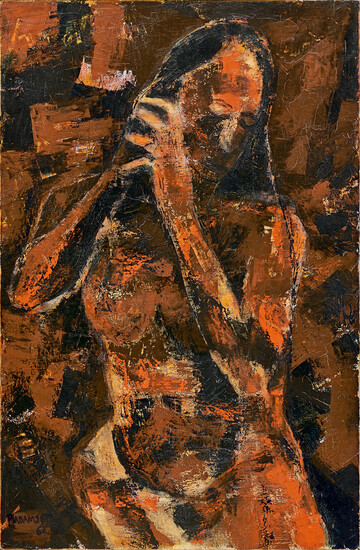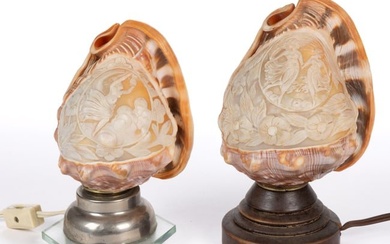Woman with Conch
PROPERTY FROM A FRENCH COLLECTION
Oil on canvas
1962
39 1/4 x 25 1/2 in. (100 x 65 cm.)
Signed and dated ‘PADAMSEE / 62’ lower left and inscribed ‘PADAMSEE / “Femme”/ 100 x 65 / IV’ on a label on reverse
LITERATURE:
Bhanumati Padamsee and Annapurna Garimella, (eds.),
Akbar Padamsee - Work in Language, Mumbai, 2010, p. 140, no. 32, illustrated.
Shamlal, Padamsee, Sadanga Series by Vakils, Mumbai, p. 22, illustrated.
‘Padamsee’s work is essentially that of a contemplative, which the not the same thing as saying that it is the work of an isolationist. Inwardness and contemplation combine with a continuing sense of search. Any sense of “harmony” or “containment” is not merely hardwon. It is tentative, precarious, mutable as life itself, as the work of any artist committed to exploring the “truths” of the inner life must be.’ (Eunice D’Souza, Akbar Padamsee, exhibition catalogue, Art Heritage, New Delhi, p. 6)
The figure is one of the two dominant themes in Akbar Padamsee’s work, and the early works from the 1950s reveal his close association with the Progressive Artists Group, and with the Indian modernist idiom. His early male heads tend to be strongly individualised and religious in theme, frequently treated in the manner of a Christian stained glass window, outlined in thick heavy black lines, enclosing glowing colours. Padamsee’s female nudes, in comparison, are less distinctive. With the exception of his early Lovers series, they are isolated figures, strong in stance yet vulnerable in appearance. They are not always beautiful, but almost always enduring. His quest was to create a new compositional order that retained a deeply humanist approach. ‘What makes Padamsee’s image of man different from all these is that it is free of all pathos, sentimentality, nostalgia and even compassion. It is as if he wants us to see that what man needs is not pity, but understanding.’ (Shamlal, Padamsee, Sadanga Series by Vakils, Mumbai, p. 6)
Padamsee’s female figures are a deliberate reflection of the painterly technique he favours for these works. The treatment of the background and the figure itself tends to be indistinguishable in parts. As they lack the heavy outlines used on his male figures, they appear as emanations that emerge out of the surroundings. However, they retain the same characteristics that Shamlal so eloquently captures. They remain essentially contemplative and self-contained. Their femininity is not what distinguishes them, despite the sometimes voluptuous proportions, and they remain ruminative and distant.
In the current work, the figure herself is graceful and limber, her face angled downward with closed eyes, seemingly absorbed in the meditative sounds emanating from the conch she holds at her right ear. Her mood seems transcendental; as if she has disconnected from her earthly surroundings. She is ‘contemplative in character, distilling a state of mind or a mood...’. This isolation, however, does not reduce the energy of the painting or the ‘tension in the figure and the way the forms emerge.’ (Ella Datta, Akbar Padamsee, New Delhi, 1988-89, p. 43) The solitary figure expresses great intensity of emotions, but never as an object of desire. She is shorn of the sexuality often present in works of other artists, thereby emphasising Padamsee’s intent to consider the female nude from a different perspective. ‘In subordinating the physical to the spiritual Padamsee strips away all non-essentials. The deep expressiveness of his paintings comes not so much from face or gesture as from the total design.’ (Shamlal, op. cit., p. 7) The choice of palette in the current work marks an inflection point from the grey period that immediately preceded this period. He felicitates this return to colour, by using a warm palette of deep oranges and reds against a darker brown background, and lighter accent tones on the figure itself. In technique as well, he has chosen a disciplined combination of palette knife and brushwork to create texture on the surface, which successfully communicates the intense emotional component for both artist and subject.
‘Extremely contemplative in character, distilling a state of mind or a mood, the paintings at the same radiate a dynamic energy in the way colours are applied, in the tension of the figures and the way the forms emerge. It is only Padamsee who can paint a nude or use erotic gestures and yet not allow women to become an object of desire.’ (Ella Datta, Akbar Padamsee, Art Heritage, New Delhi, 1988-1989, p. 43)
# Import duty at 11% will be charged on the hammer price and GST will be applicable on the total amount of the hammer price plus the import duty.
Condition: The colours of the original are slightly richer than the catalogue illustration. Paint shrinkage visible in the background tones of the painting, as visible in the catalogue illustration. Minor chips and abrasions to the paint surface along the extreme edges of the canvas. Further pigment loss to the background brown directly above the figure’s raised left hand. Overall good condition.
View it on
Sale price
Estimate
Reserve
Time, Location
Auction House
PROPERTY FROM A FRENCH COLLECTION
Oil on canvas
1962
39 1/4 x 25 1/2 in. (100 x 65 cm.)
Signed and dated ‘PADAMSEE / 62’ lower left and inscribed ‘PADAMSEE / “Femme”/ 100 x 65 / IV’ on a label on reverse
LITERATURE:
Bhanumati Padamsee and Annapurna Garimella, (eds.),
Akbar Padamsee - Work in Language, Mumbai, 2010, p. 140, no. 32, illustrated.
Shamlal, Padamsee, Sadanga Series by Vakils, Mumbai, p. 22, illustrated.
‘Padamsee’s work is essentially that of a contemplative, which the not the same thing as saying that it is the work of an isolationist. Inwardness and contemplation combine with a continuing sense of search. Any sense of “harmony” or “containment” is not merely hardwon. It is tentative, precarious, mutable as life itself, as the work of any artist committed to exploring the “truths” of the inner life must be.’ (Eunice D’Souza, Akbar Padamsee, exhibition catalogue, Art Heritage, New Delhi, p. 6)
The figure is one of the two dominant themes in Akbar Padamsee’s work, and the early works from the 1950s reveal his close association with the Progressive Artists Group, and with the Indian modernist idiom. His early male heads tend to be strongly individualised and religious in theme, frequently treated in the manner of a Christian stained glass window, outlined in thick heavy black lines, enclosing glowing colours. Padamsee’s female nudes, in comparison, are less distinctive. With the exception of his early Lovers series, they are isolated figures, strong in stance yet vulnerable in appearance. They are not always beautiful, but almost always enduring. His quest was to create a new compositional order that retained a deeply humanist approach. ‘What makes Padamsee’s image of man different from all these is that it is free of all pathos, sentimentality, nostalgia and even compassion. It is as if he wants us to see that what man needs is not pity, but understanding.’ (Shamlal, Padamsee, Sadanga Series by Vakils, Mumbai, p. 6)
Padamsee’s female figures are a deliberate reflection of the painterly technique he favours for these works. The treatment of the background and the figure itself tends to be indistinguishable in parts. As they lack the heavy outlines used on his male figures, they appear as emanations that emerge out of the surroundings. However, they retain the same characteristics that Shamlal so eloquently captures. They remain essentially contemplative and self-contained. Their femininity is not what distinguishes them, despite the sometimes voluptuous proportions, and they remain ruminative and distant.
In the current work, the figure herself is graceful and limber, her face angled downward with closed eyes, seemingly absorbed in the meditative sounds emanating from the conch she holds at her right ear. Her mood seems transcendental; as if she has disconnected from her earthly surroundings. She is ‘contemplative in character, distilling a state of mind or a mood...’. This isolation, however, does not reduce the energy of the painting or the ‘tension in the figure and the way the forms emerge.’ (Ella Datta, Akbar Padamsee, New Delhi, 1988-89, p. 43) The solitary figure expresses great intensity of emotions, but never as an object of desire. She is shorn of the sexuality often present in works of other artists, thereby emphasising Padamsee’s intent to consider the female nude from a different perspective. ‘In subordinating the physical to the spiritual Padamsee strips away all non-essentials. The deep expressiveness of his paintings comes not so much from face or gesture as from the total design.’ (Shamlal, op. cit., p. 7) The choice of palette in the current work marks an inflection point from the grey period that immediately preceded this period. He felicitates this return to colour, by using a warm palette of deep oranges and reds against a darker brown background, and lighter accent tones on the figure itself. In technique as well, he has chosen a disciplined combination of palette knife and brushwork to create texture on the surface, which successfully communicates the intense emotional component for both artist and subject.
‘Extremely contemplative in character, distilling a state of mind or a mood, the paintings at the same radiate a dynamic energy in the way colours are applied, in the tension of the figures and the way the forms emerge. It is only Padamsee who can paint a nude or use erotic gestures and yet not allow women to become an object of desire.’ (Ella Datta, Akbar Padamsee, Art Heritage, New Delhi, 1988-1989, p. 43)
# Import duty at 11% will be charged on the hammer price and GST will be applicable on the total amount of the hammer price plus the import duty.
Condition: The colours of the original are slightly richer than the catalogue illustration. Paint shrinkage visible in the background tones of the painting, as visible in the catalogue illustration. Minor chips and abrasions to the paint surface along the extreme edges of the canvas. Further pigment loss to the background brown directly above the figure’s raised left hand. Overall good condition.






